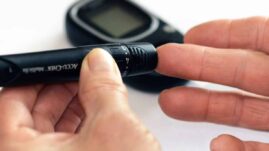There are many reasons to avoid or quit smoking cigarettes — and diabetes is definitely one of those reasons. Whether you already have type 1 or type 2 diabetes, or you’d like to prevent developing type 2 diabetes, quitting smoking is a critical part of your long-term health.
In fact, the more cigarettes you smoke per day, the greater your risk of developing type 2 diabetes becomes. Compared to non-smokers, you are 30 to 40 percent more likely to develop diabetes.
In this article, we’ll discuss why smoking increases your risk of developing type 2 diabetes and increases the development of diabetes-related complications.
How cigarettes worsen your risk of diabetes, insulin resistance, and complications
Smoking cigarettes worsen your blood sugars and overall insulin resistance in four ways:
- Nicotine makes insulin less effective
- Smoking causes whole-body inflammation
- Smoking creates oxidative stress (which leads to complications)
- Increases belly fat and cortisol levels
Let’s take a closer look.
Makes insulin less effective
Whether you are a non-diabetic or you’ve been diagnosed, cigarette smoking has a major impact on your insulin sensitivity, increasing a non-diabetic’s risk of type 2 diabetes tremendously.
Nicotine increases your level of insulin resistance tremendous every time your body is exposed to nicotine. And it takes anywhere from 8 to 48 hours for nicotine to leave your body after smoking one cigarette.
“We found a linear dose-response relationship between cigarette consumption and type 2 diabetes risk; the risk of type 2 diabetes increased by 16% for each increment of 10 cigarettes smoked per day,” explained a 2017 study from Japan.
“The risk of type 2 diabetes remained high among those who quit during the preceding 5 years but decreased steadily with increasing duration of cessation, reaching a risk level comparable to that of never smokers after 10 years of smoking cessation.”
The researchers concluded that an estimated 18.8 percent of men and 5.4 percent of women with type 2 diabetes were attributable to smoking cigarettes.
Simply put, when nicotine is present in your body, insulin is less effective. The more you smoke, the more insulin you’ll need in order to manage your blood sugars.
Whole-body inflammation
Smoking also increases insulin resistance by causing tremendous inflammation throughout the entire body.
“Smoking causes general adverse effects on the body, including inflammation and decreased immune function,” explains the CDC.
Further research only recently pinpointed exactly how this inflammation develops.
“Scientists show that nicotine activates certain white blood cells, called neutrophils, which in turn release molecules that lead to increased inflammation,” explains a 2016 study from the Federation of American Societies for Experimental Biology.
This research also gave experts deeper insight into smoking’s relationship with autoimmune diseases.
“Because of the direct link between nicotine itself and inflammation, this study has important implications including that alternative forms of nicotine inhalation, such as vaping that lacks other chemicals from cigarette smoke, may nonetheless still have detrimental immunological effects.”
Creates oxidative stress (which leads to complications)
“Smoking also causes oxidative stress, a condition that occurs as chemicals from cigarette smoke combine with oxygen in the body.”
This combination then causes further damage to cells throughout your entire body.
For those with any type of diabetes, this is the primary reason that smoking increases the likelihood of developing diabetes complications.
“It is becoming clear that oxidative stress and inflammation are significant risk factors for the development and sustained cellular injury of type 1 and type 2 diabetic complications,” explains 2018 study from Australia.
“This holds true for all diabetic complications, including diabetes‐associated atherosclerosis with its underlying endothelial dysfunction, diabetic nephropathy, diabetic retinopathy, and diabetic cardiomyopathy.”
Additional research from Poland in 2017 found further evidence concluding the direct link between smoking and complications.
“Distinct studies of smoking in patients with diabetes have unambiguously confirmed an increased prevalence and a higher risk of early death associated with the development of macrovascular complications.”
Increases belly fat and cortisol
In addition to increasing your insulin needs, it’s also linked to more belly fat, obesity, and cortisol. All of which then further add to insulin resistance.
“Although smokers have a lower mean body mass index compared with never-smokers, heavier smokers have a more metabolically adverse fat distribution profile, with higher abdominal and visceral adiposity than lighter ones,” explains a 2012 study from South Korea. “This observation reflects the metabolic consequences of smoking.”
Smoking’s impact on your cortisol production seems minor at first, but its impact on those with or at risk of type 2 diabetes is considered major.
“The effect size of smoking on cortisol secretion is small to moderate, but this consistent effect every day over many years may potentially have large consequences on downstream endocrine function,” explains the Journal of Clinical Endocrinology and Metabolism.
“For example, evidence suggests that the moderately raised cortisol levels observed in smokers would potentially have large impacts on glucose and insulin metabolism.”
Regardless of the facts and research, cigarettes are extremely addictive. This means that no matter how well you understand their detriment to your health, quitting them all together means overcoming the many side-effects of nicotine withdrawal.
Quitting smoking: top tips for people with diabetes
One of the biggest concerns any smoker likely has when it comes to quitting is weight-gain. If you have diabetes, that concern is even more valid.
Here are some tips from the Cleveland Clinic’s Tobacco Treatment Center on quitting smoking without gaining weight:
Expect a big spike in your appetite
When you quit smoking, your appetite is going to increase significantly. You should be prepared for this and have a plan in place beyond simple willpower. Willpower runs out. Instead, strive to keep yourself well-fed by eating a small meal or snack every 3 to 4 hours.
Choose mostly whole foods (ie: real food) versus processed, packaged items, and remember to get fat or protein with every meal.
For example, snacks could be an apple with peanut butter, or baby carrots and cheese.
Meals should include plenty of fiber-full, chewy vegetables, along with protein and a careful portion of whole grains if they are already part of your diet and you know your blood sugar can handle them!
The more you can fill your stomach with real food — especially vegetables — the more stable your blood sugar will be, and the more you’ll prevent weight-gain.
And don’t forget about water! Drink, drink, drink. A hydrated body craves far less junk-food than a dehydrated body. Drinking water is also a great distraction from those cravings.
Start exercising every day.
When nicotine is present in the body, your metabolism actually increases temporarily. When you quit smoking, your metabolism goes back to your normal, natural rate. To compensate — and keep your metabolism burning aplenty — you’ll be wise to start exercising regularly.
Exercise is also going to play a big role in repairing your overall health — especially your insulin sensitivity and your blood sugar levels.
It doesn’t have to be crazy. Just get up and go for a 15 to 30-minute walk once a day during your lunch break, right after work, or after dinner. Get up. Get moving.
Create a new routine during times of day you used to smoke.
You’re likely used to having a cigarette after a meal, which is telling your body that the meal is over and you can stop eating. Without this, you can wind up feeling like you just want to eat and eat and eat.
Or maybe you used smoking as an excuse to get fresh air in the middle of your workday?
Instead, create new rituals and routines for the times of day you used to smoke. Go for a brisk walk rather than just standing outside the building. Pop a piece of minty gum after dinner. Brush your teeth after every meal to create that “you’re done eating” experience.
If you can pinpoint all of the routines you had around the activity of smoking cigarettes, write them down and start coming up with new routines. Willpower alone isn’t enough.
Occupy your hands and mouth with healthier items.
Just like your routines, smoking also gave you something to do with your mouth and hands (and perhaps your anxious energy).
You may need to chew on raw vegetables (carrots or celery), gum, or keep a pack of mints in your bag at all times.
Remind yourself: the benefits of quitting outweigh a little weight-gain
Even if you do gain a little weight after quitting, the benefits of getting cigarettes out of your body and your life far outweigh the negatives of weight-gain.
“There are approximately 600 ingredients in cigarettes,” explains the American Lung Association. “When burned, cigarettes create more than 7,000 chemicals. At least 69 of these chemicals are known to cause cancer, and many are toxic.”
If you take insulin or other diabetes medications…
Within about 2 months of quitting smoking, you may see your insulin needs start to come down which can mean you might experience more low blood sugars. If you’re eating and snacking more, this may prevent those lows.
Regardless, talk to your doctor during the first month you start quitting cigarettes to discuss any necessary adjustments in your insulin doses. The more you share your goal, the more support you’ll have!
If you’re ready to change your life and improve how you feel on a daily basis, it’s time to quit!
For more support in your quest to quit smoking, visit Lung.org.



